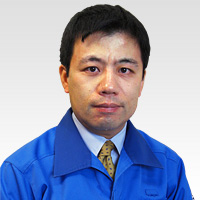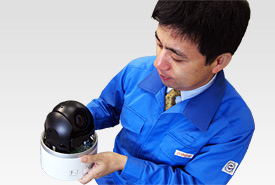Atsushi Yamashita - Product Engineer
~ Direct Drive Motor - Newly-developed mechanism to offer precise and highly responsive pan/tilt movement

Mr. Yamashita, Development Team
The "VN-V686" series PTZ dome camera, which JVC added to its lineup in 2007, has made a big impression, having already been nominated for and received a number of awards in North America and Europe. This is not just because of its excellent picture quality and its outstanding distribution capacity as a network camera. JVC developed a completely new pan/tilt mechanism and added this innovative feature to the VN-V686 when it was launched. The new pan/tilt mechanism, called "Direct Drive," is without question a major reason for the further leap in quality of JVC's PTZ dome cameras. In this section, we interview an engineer about the development of the new "Direct Drive" technology at the heart of the VN-V686.
- What was your contribution to the quality of the product as a mechanical designer? And what were you aiming to achieve with the new VN-V686 series?
First of all, we used a simple mechanism with few components to dramatically lower the probability of failure and therefore enhance reliability.
Furthermore, on the operating side, we were seeking a mechanism to move the PTZ camera more smoothly even as we tried to achieve something we've long wanted in such cameras: the ability to move at ultra-low and ultra-high speeds. Existing gear-and-belt driven PTZ cameras use a stepping mechanism, so at slow speeds their movements are choppy and at fast speeds they make a whirring noise. We developed the Direct Drive mechanism as a fundamental way of solving that problem.
- What was the breakthrough point for the Direct Drive?
We took a hint from the mechatronics technology that controls VTR tapes, specifically the way an editing machine's motor freely controls fast forwarding and rewinding. This mechanical technology can work smoothly at any speed. JVC has excellent know-how in professional editing machines, as is well known with the development of commercial VTRs. With long experience and know-how in VTR development, we felt confident about the control technologies and component selection.

- Was it easy to transplant the technology? Did development take much time?
Development took about three years, dating from the idea stage. For some parts, we were able to take advantage of the merits of VTR control mechanism as is, but developing the control part and building in precision tuning so that we could stop the pan/tilt motion at exactly the right point was a real battle. Essentially, motors are very good at continuous rotation at uniform speed and can turn at very high speeds, but stopping is their weakness. In order to realize a preset position function, however, which is to be expected on a PTZ camera, it was crucial to be able to stop instantly in the correct position. Achieving that is what led us to the successful development of the Direct Drive mechanism.
The VN-V686 series has achieved stopping control within ±0.03° . With the stepping motion you get with an existing gear-and-belt driven PTZ, you can't get precision any better than the amount of movement in one step. In general you can't do better than about ±0.1° . Just looking at this difference in specifications, I think you can tell that precision of ±0.03° is a great advance.

Direct Drive Sample movie
- What advantages does that offer on the operating side?
- Will competitors soon be imitating this outstanding idea?
It is certainly outstanding technology, so it's quite possible that in the future customers will demand the same kind of performance from all PTZ cameras. But as I mentioned earlier, it's very important to have motor control know-how to develop this technology. Without that, you have a runaway camera, which moves fast enough but can't be controlled. I also mentioned at the beginning that this control technology is based on VTR editing machine mechatronics technology.
To provide all that, you have to have a deep knowledge of VTR editing machine control technology, and outstanding CCTV camera development technology. Aside from JVC, do you know any manufacturers like that?
- What future directions do you have in mind for JVC PTZ cameras?
Naturally, we'd like to put the Direct Drive on all models, and I foresee a day in the future when our cameras will have even more advanced high-powered motor. Other than that, it's absolutely critical to make cameras smaller and PoE-ready. It's our goal to develop PoE-ready cameras that will offer the same performance even with their limited power supply. You can expect great things from JVC's future network PTZ camera series.